Key statistics
Nearly 65% of U.S. shelters are now considered no-kill, up from just 24% in 2016.
The national shelter save rate is 83-85%, meaning 4 out of 5 pets now make it out of shelters alive.
689,000 dogs and cats were still euthanized in U.S. shelters in 2023 — down from 2.6 million in 2011 and 15 - 20 million in the 1970s.
Texas, California, North Carolina, Florida, and Louisiana have the highest euthanasia rates
Delaware and New Hampshire are the only official no-kill states, maintaining a 90%+ save rate statewide.
Austin, TX has maintained a 95%+ live release rate for over a decade.
Shelters experiencing overcrowding have euthanasia rates up to 3x higher than those with steady adoption and intake balances.
Pit Bulls make up 30–40% of shelter dog intakes and have lower adoption rates. In some areas, up to 93% of Pit Bulls are euthanized due to breed bans, low adoption demand, and stigma.
Shelters with strong community funding and volunteer programs are 40% more likely to reach no-kill status than underfunded shelters.
Fostering just 2% more pets nationwide could completely eliminate euthanasia for space-related reasons, preventing thousands of unnecessary deaths.
Only 20% of U.S. states require shelters to publicly report euthanasia statistics.
85% of people support no-kill shelters, yet only 40% adopted their last pet from a shelter.
Germany, Sweden, and the UK have achieved de facto no-kill through strict pet ownership laws and strong sterilization programs.
Taiwan made shelter euthanasia illegal in 2017, while the U.S. still has no federal no-kill law.
Quick Navigation
The Evolution of No-Kill Shelters in the U.S.
Here's how the no-kill movement has evolved:
✔ 15–20 million shelter animals euthanized annually in the 1970s, with minimal efforts to rehome or provide alternatives.
✔ The first high-volume spay/neuter programs launch, helping reduce unwanted litters.
✔ 1984: Best Friends Animal Society is founded, later becoming a national leader in no-kill advocacy.
✔ 1994: San Francisco becomes the first U.S. city to commit to no-kill policies, proving large-scale lifesaving was possible.
✔ Nationwide adoption campaigns and “Adopt, Don't Shop” messaging become mainstream.
✔ 2004: The Asilomar Accords introduce standardized data tracking, helping shelters measure progress.
✔ 2010: The Humane Society of the U.S. (HSUS) declares that high euthanasia rates are “no longer acceptable.”
✔ 2019: Delaware becomes the first official no-kill state, proving statewide success is achievable.
✔ Nearly 65% of shelters in the U.S. are now no-kill (up from 24% in 2016).
✔ The U.S. shelter save rate has risen to 83–85%, a historic high.
✔ Best Friends Animal Society leads the national push for No-Kill 2025, aiming to ensure a 90%+ save rate nationwide.
✔ More cities and states, like Austin, TX, and New Hampshire, sustain long-term no-kill success.
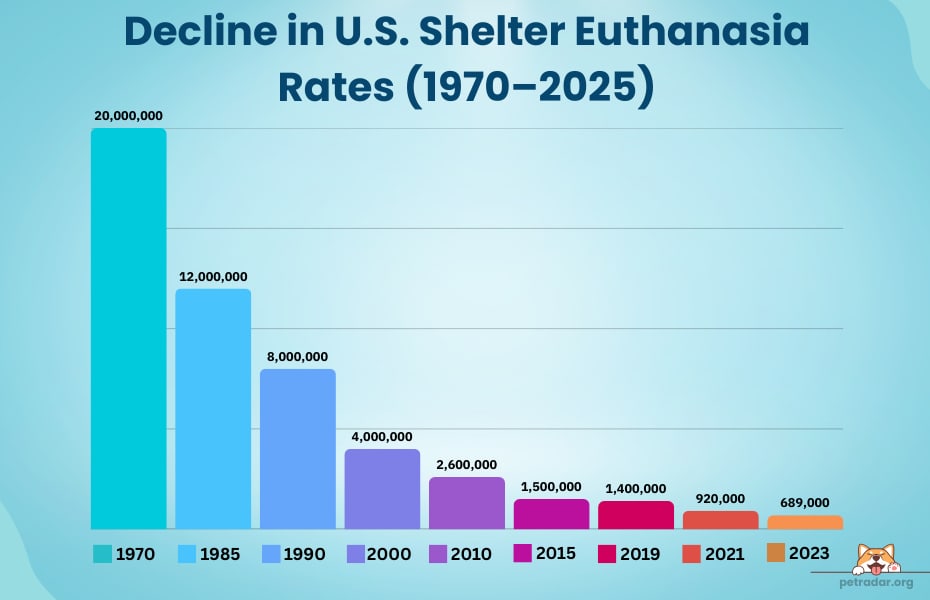
Where the U.S. Stands Today: Shelter Stats and Trends
The No-Kill Benchmark: Are We There Yet?
✔ Nearly 65% of U.S. shelters are now no-kill, a massive increase from just 24% in 2016.
✔ The national save rate has climbed to 83–85%, meaning about 4 out of 5 shelter pets are making it out alive.
✔ Some states, like Delaware and New Hampshire, have fully reached no-kill status, while others - particularly in the South - are still working to close the lifesaving gap.
How Many Pets Are Still Being Euthanized?
What's Driving the Progress?
✔ Increased Shelter Transparency and Data Tracking – Organizations like Best Friends Animal Society and Shelter Animals Count have made it easier to identify problem areas and improve outcomes.
✔ Growing Public Support for Adoption – The "Adopt, Don't Shop" movement has shifted public attitudes, making shelter adoption more mainstream.
✔ Rescue Transfers and Transport Programs – Moving pets from overcrowded, high-risk shelters to areas with more adopters has saved thousands of lives.
✔ Foster Programs and Community Engagement – More shelters are relying on foster homes to keep animals out of cages and in loving temporary homes until they find permanent families.
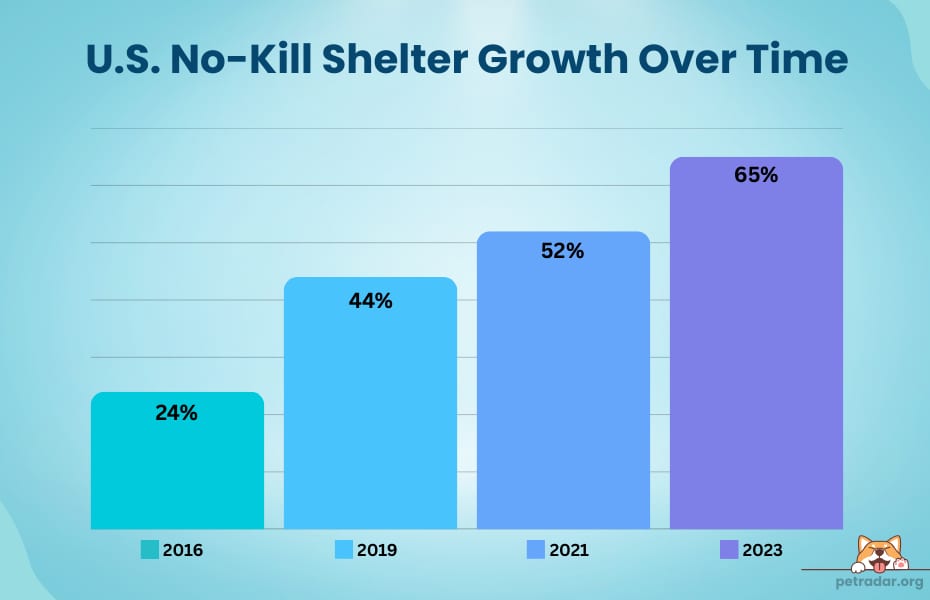
How the U.S. Compares to Other Countries in No-Kill Efforts
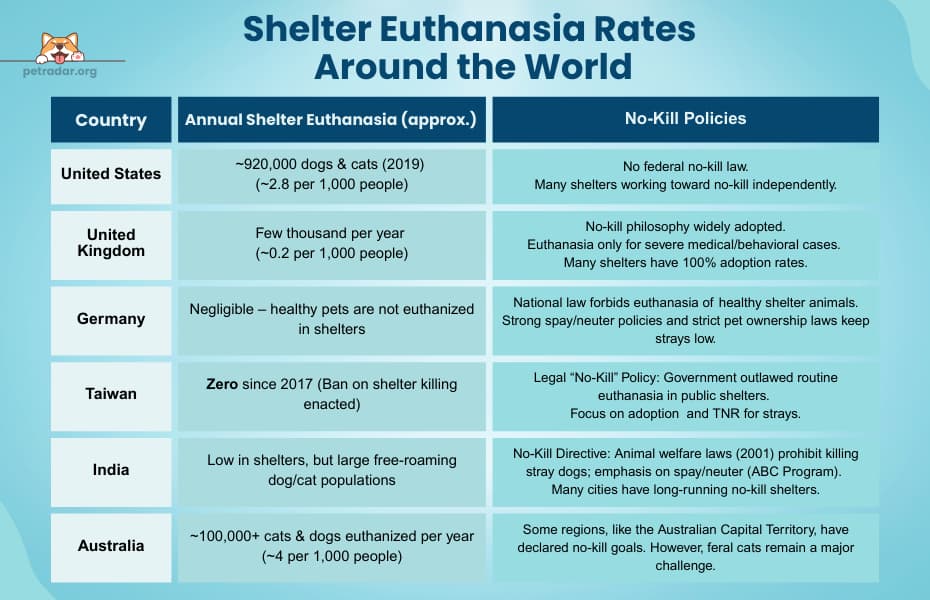
🔍 What No-Kill Countries Did Right
Countries like Germany and Taiwan enforce legal no-kill policies, ensuring that euthanasia is only used for medical or severe behavioral cases. In contrast, the U.S. relies primarily on voluntary efforts and nonprofit initiatives.
Nations with low euthanasia rates have strong mandatory spay/neuter laws or well-funded sterilization programs. In contrast, the U.S. still struggles with stray populations, particularly in Southern states with lower spay/neuter rates.
In many European countries, adopting from shelters is the norm, and buying pets from breeders or pet stores is less common. Meanwhile, in the U.S., public education campaigns have improved adoption rates, but some communities still hesitate to adopt shelter animals due to outdated stigmas.
India and other no-kill nations embraced TNR (Trap-Neuter-Return) programs instead of euthanizing community cats. India's focus on sterilization has stabilized populations without mass culling. Expanding TNR in the U.S. could drastically reduce feline euthanasia rates.
What's Stopping More Shelters from Going No-Kill?
1.Overcrowding and Limited Space
✔ High-intake shelters in crowded urban areas or regions with loose spay/neuter laws often struggle to keep up.
✔ Without serious foster programs or adoption initiatives, pets may be euthanized simply due to space constraints.
✔ Rural areas often have fewer adopters and fewer transport networks, making it harder to move pets to areas with higher demand.
2. Funding and Staffing Shortages
✔ Low-budget shelters often lack veterinary care, making it difficult to treat minor medical issues and keep animals adoptable.
✔ Understaffed shelters can't provide enrichment, training, or behavioral rehabilitation, leading to more pets being labeled as “unadoptable.”
✔ Shelters with limited marketing budgets struggle to attract adopters, leaving pets sitting in kennels for months.
3. Low Adoption and Foster Rates in Some Regions
✔ Areas with lower pet adoption rates experience longer shelter stays, increasing the risk of euthanasia.
✔ In some rural areas, fewer people spay/neuter their pets, leading to constant intake of unwanted litters.
✔ Some shelters don’t have strong community outreach programs, meaning fewer people even know about the adoptable pets waiting for homes.
4. Breed-Specific Challenges and Misconceptions
✔ Many cities still ban breeds like Pit Bulls, making it nearly impossible to adopt them out.
✔ Large dogs generally have longer shelter stays compared to smaller breeds.
✔ Public misconceptions about certain breeds make adopters hesitant, even when dogs have no behavioral issues.
5. Lack of Spay/Neuter Access in Certain Areas
✔ Unaltered pets reproduce rapidly, increasing shelter intake year after year.
✔ Some areas lack low-cost spay/neuter clinics, making it difficult for owners to fix their pets.
✔ Without TNR (Trap-Neuter-Return) programs for feral cats, shelters end up euthanizing thousands of kittens every year.
6. Gaps in Shelter Policies and Legislation
✔ Some states require shelters to hold animals for a certain period before euthanasia, while others allow euthanasia within hours of intake.
✔ Transparency laws vary. Some shelters report euthanasia numbers publicly, while others do not.
✔ Some states have no laws requiring shelters to work with rescues, meaning adoptable pets are sometimes euthanized despite available alternatives.
7. Public Misconceptions and Awareness Gaps
✔ Some people assume “no-kill” means shelters never euthanize animals, when in reality, a no-kill shelter can still euthanize up to 10% of pets for severe medical or behavioral issues.
✔ Potential adopters may not realize how many shelter pets need homes, leading them to buy from breeders instead.
✔ Many people believe only mixed-breed pets end up in shelters, but purebred dogs and cats make up nearly 25% of shelter populations.
✔ More funding & resources
✔ Widespread spay/neuter & TNR programs
✔ Public education & adoption awareness
✔ Legislative action to standardize shelter policies
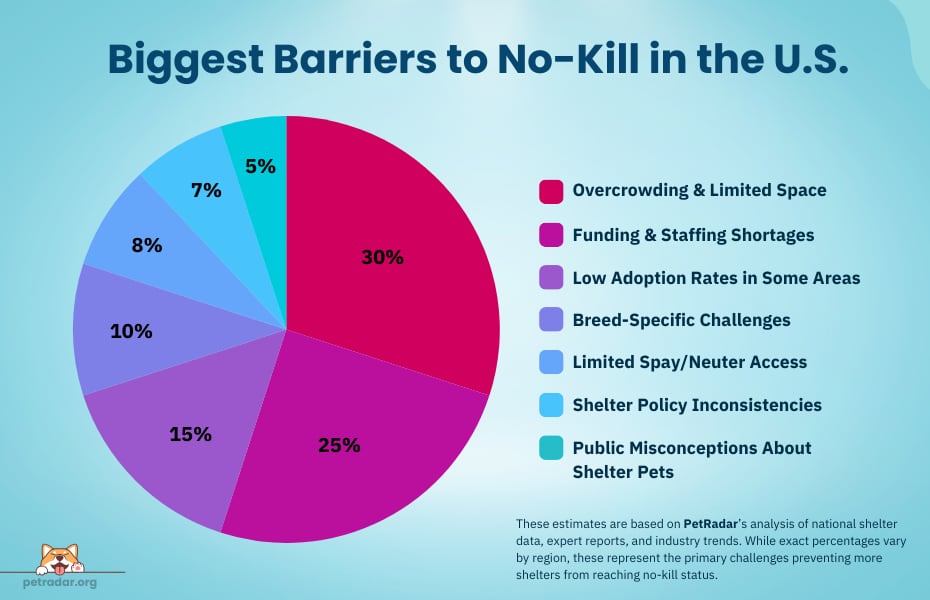
The No-Kill Success Stories: Cities and Shelters Leading the Way
🏆 Austin, TX – The Largest No-Kill City in the U.S.
✔ A city ordinance mandating no-kill policies
✔ Heavy investment in foster care and adoption programs
✔ Specialized rescue efforts for medical and behavioral cases
✔ Strong collaboration between public and private organizations
🏆 Kansas City, MO – From High-Kill to No-Kill in Record Time
✔ Transitioning shelter operations from the city to a nonprofit
✔ Expanding community involvement with volunteer and foster programs
✔ Increasing adoption events and marketing campaigns
✔ Offering behavior rehabilitation programs for hard-to-adopt dogs
🏆 Portland, OR – A No-Kill Network That Works
✔ A regional coalition of shelters and rescues working together
✔ A shared database system to track and manage shelter animals across multiple facilities
✔ Community-wide spay/neuter efforts to reduce intake
✔ Relocation and transport programs to move animals to areas with higher adoption demand
🏆 Jacksonville, FL – No-Kill Through a Citywide Effort
✔ Large-scale low-cost spay/neuter programs to prevent unnecessary intake
✔ A strong safety net for pet owners, including food assistance and vet care subsidies
✔ Free and low-cost adoption events to encourage placement of shelter animals
✔ Strong public engagement campaigns and citywide advocacy
🏆 Tompkins County, NY – The First No-Kill County in the U.S.
✔ Leadership that committed fully to no-kill policies
✔ A strong community-driven foster and adoption network
✔ Proactive pet retention programs to reduce owner surrenders
✔ Strong fundraising efforts to improve shelter resources
🔥 Common Themes of No-Kill Success Stories:
Public-private partnerships between government shelters and nonprofit rescues
Proactive spay/neuter programs to reduce intake
Community-supported foster programs to free up shelter space
Innovative adoption campaigns to move animals out faster
Leadership that commits to lifesaving, even when it's difficult
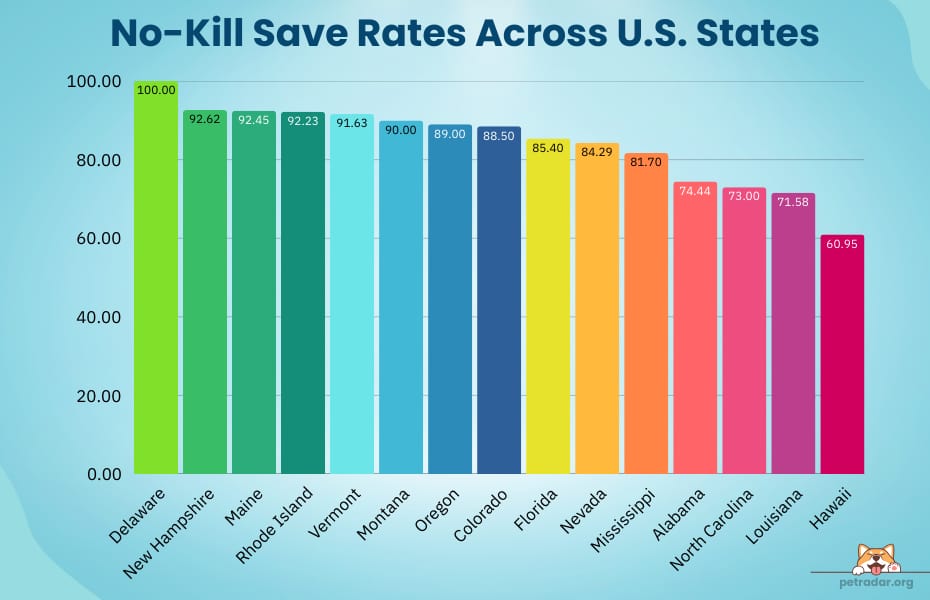
The Future of No-Kill: What's Needed to Get to 100%?

1. Expanding High-Impact Lifesaving Programs
✅ Community Cat TNR (Trap-Neuter-Return) Programs – The majority of shelter euthanasia still involves cats, especially unweaned kittens. Instead of bringing in feral or free-roaming cats that aren't adoptable, shelters need more support for TNR programs, which allow these cats to live safely in the community while preventing future litters.
✅ Foster Programs to Reduce Overcrowding – If more people opened their homes, even temporarily, fewer animals would be at risk. Fostering takes pressure off shelters, gives pets a stress-free environment, and increases their chances of adoption. Encouraging even short-term “weekend fostering” programs can help keep shelters from reaching capacity.
✅ Improved Pet Retention Efforts – Many pets are surrendered due to solvable problems such as medical costs, housing restrictions, or minor behavioral issues. Offering pet food banks, financial aid for veterinary care, and free training resources could prevent countless pets from entering the shelter system in the first place.
2. Expanding High-Impact Lifesaving Programs
✅ More States Passing No-Kill Laws – Some states, like Delaware, have implemented laws requiring shelters to exhaust all rescue and adoption options before euthanizing an animal. Expanding these laws nationwide could create a safety net for shelter pets.
✅ Stronger Tenant Protections for Pet Owners – One of the top reasons pets are surrendered to shelters is housing restrictions - landlords not allowing pets or charging excessive fees. Encouraging pet-friendly housing policies (or banning breed-based restrictions) could prevent thousands of unnecessary surrenders.
✅ Incentives for No-Kill Compliance – Shelters that reach a 90%+ save rate should receive state or federal grants to continue improving their programs. Providing funding for no-kill initiatives will make lifesaving efforts sustainable
3. Public Awareness & Cultural Shifts
✅ Breaking the Myths About Shelter Pets – Many people still believe shelter pets are “broken” or that specific breeds are bad family dogs. Public education campaigns (especially in areas with high euthanasia rates) are needed to shift perspectives and increase adoption rates.
✅ Community Engagement & Volunteering – Many no-kill shelters rely on volunteers and foster networks. The more people willing to help, the more animals that can be saved. Encouraging people to foster, donate, or volunteer at their local shelter can make a direct impact.
✅ Stronger Social Media & Networking for Pets in Need – The power of social media in rehoming pets has never been stronger. Promoting shelter animals online, making adoption stories go viral, and using digital tools to connect pets with potential adopters could save countless lives.

A Nationwide No-Kill Commitment
If every shelter in the U.S. implemented proven no-kill programs, expanded foster and adoption efforts, and had the funding to sustain these changes, the U.S. could reach full no-kill status within a few years 🐾
If just 2% more pet-owning households fostered or adopted from shelters, euthanasia for space could be eliminated entirely 🐾
If state and local governments prioritized no-kill policies and funding, even struggling shelters could transform into lifesaving organizations 🐾



